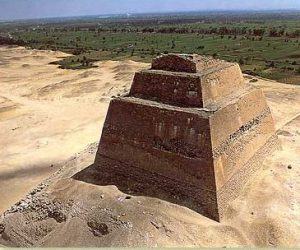
The Pyramid of Meidum is ascribed to King Huni, the last king of the Third Dynasty. Its completion was undertaken by King Sneferu, the first king of the Fourth Dynasty. The pyramid complex, which is the oldest known complex, consists of the mortuary and the valley temples as well as the causeway. On the walls of the mortuary temple was found a text written by the visitors of the site in the time of King Thutmosis III attributing the pyramid's construction to King Sneferu. The construction of the Pyramid of Meidum took different phases. It began as a seven-mastaba step pyramid. Later, another mastaba was added and finally Sneferu filled the mastabas with blocks converting it into a true pyramid. The pyramid, in its actual state, measures 300ft/92m high. The entrance to the pyramid is 20 meters above the ground level in the north side of the pyramid. There is a 57-meter descending passage leading to a horizontal passage below the ground level. The last passage leads to a vertical shaft that ends in the burial chamber. The pyramid's necropolis includes many important mastabas, among which is Mastaba #17 (next to the pyramid), the owner of which is unknown. It contains the oldest granite sarcophagus. Its original entrance is still closed, but the entry to its internal parts is through an entrance that was cut by robbers. There is also the famous Mastaba of Rahotep and his wife Nofret, the owners of the famous statue in the Cairo Museum. The Mastaba of Nefernaat and his wife Atet is also included in the site. On the mastaba's walls were many gracefully painted reliefs, among which was the relief of the Geese of Meidum. These mastabas date back to the end of the Third Dynasty, and the beginning of the Fourth Dynasty.
